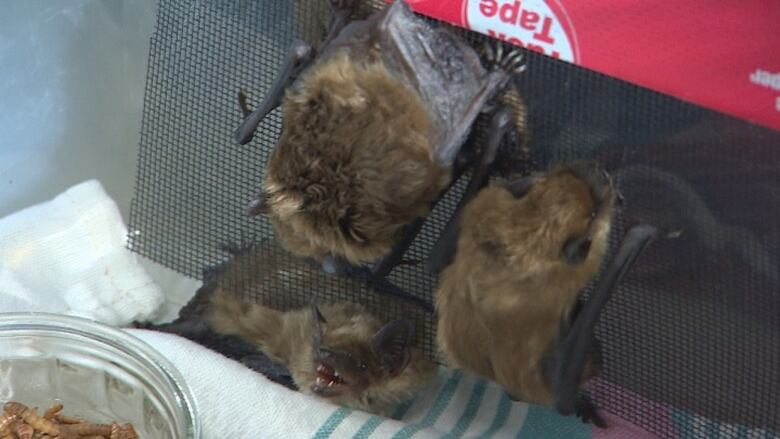Large hibernating bat colony found living in Saskatchewan curling rink
386 bats were found, but not all of them survived

A team of volunteers are nursing a colony of bats back to health and into hibernation.
The big brown bats, a species commonly found throughout North America, were discovered in the attic of a curling rink in the town of Unity.
Dave Pentecost, who owns DTS Roofing & Bat Services Ltd., was contacted by the town to remove them after they were discovered during a renovation.
Within 200 square feet, 386 bats were found.
"It's definitely Top 5 biggest colonies for us for sure," said Seth Pentecost, who has removed colonies throughout western Canada.
Pentecost and his son, Seth, have spent much of February safely removing them from the rink, which was built in the 1960s.
"It takes the tip of your baby finger for them to get in. So when people are building these houses or arenas, they shift and areas have moved. Stuff has worn out, so there are tons of places to get in," Seth Pentecost said.
'I was hoping he was overestimating'
Volunteers at Living Sky Wildlife Rehabilitation have been taking care of the bats since Friday morning.
They were contacted by Dave Pentecost who said he had two plastic tubs filled with bats — somewhere between 200 to 400.
"I was hoping he was overestimating, but he wasn't," executive director of Living Sky Wildlife Rehabilitation Jan Shadick said.
Of the 386 bats, some didn't make it due to lack of food and the stress from moving.
"In hibernation, they're working off their stored fat, so when you wake them up they start to burn off that stored fat. But there are no insects out there," Shadick said.

As for the others, their disposition wasn't great.
"They had really gotten frustrated with each other and had taken a chomp out of each other frequently. But if you can imagine being in a twin bed with like 10 people, you would get pretty irritated too with your bedmates," Shadick said.
The organization quickly set up a system of volunteers to process every bat.
In total, 323 bats lived through the process. They were weighed, examined, hydrated and fed mealworms.
"If they were a sufficient weight, they went back into hibernation and we had several tubs waiting for them," Shadick said.

The bats who did go back into hibernation are being stored in temperature-controlled rooms between 5 C to 15 C.
Another 75 bats continue to be underweight, therefore are not ready to go back into hibernation.
For a week and a half, a team of three to four people has spent six hours a day feeding them in hopes of fattening them up.
"Once they hit this golden number in weight, then we can pass them off and put them in hibernation," Shadick said.
"It's amazing the way nature has created these phenomenal adaptations for survival."
More bats being discovered at the rink
The Pentecosts and Shadick say it's likely hundreds more will be discovered at the Unity curling rink.
"There's a potential for a lot more. Most of these bats were male, so there is likely to be a maternity colony in there — a whole bunch of females," Shadick said. "It's an old building, it's been there forever, and the bats have really benefited from that."

On Monday, the Pentecosts found another 68 bats, which will be sent to Living Sky Wildlife Rehabilitation.
So far, they've searched about 3,000 square feet of the building, but with the rink being 10,400 square feet, they have over 7,000 square feet to comb through.
Finding the bats a new home
The Living Sky Wildlife Rehabilitation centre says they want to work with the town to come up with options for the bats.
Once spring comes, the bats will come out of hibernation and will be released back into the wild in the Unity area. But they will still need a place to hibernate.

Shadick is hoping to build a large winterized bat house for them so they don't return to public spaces.
"It would smell like them, and we'd be able to transport them in the box back to where the town or area is," Shadick said.
"And when they emerge from there and go about their business it will be as if it was a horrible nightmare, and the aliens didn't really abduct them."
